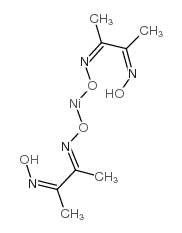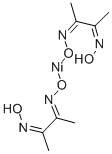二甲基乙二肟镍(II) ,Dimethylglyoxime dinickel salt ,99.9%
产品编号:Bellancom-B252501| CAS NO:13478-93-8| 分子式:C8H14N4NiO4| 分子量:288.9146
本网站销售的所有产品仅用于工业应用或者科学研究等非医疗目的,不可用于人类或动物的临床诊断或者治疗,非药用,非食用,
| 英文名称 | Dimethylglyoxime dinickel salt |
|---|---|
| CAS编号 | 13478-93-8 |
| 产品熔点 | 250ºC (subl.) |
| 产品沸点 | 192ºC at 760mmHg |
| 产品闪点 | 69.9ºC |
| 精确质量 | 288.03700 |
| PSA | 108.36000 |
| LogP | 1.38660 |
| 蒸气压 | 0.134mmHg at 25°C |
| 稳定性 | 常温常压下稳定 避免的物料 氧化剂 |
| 储存条件 | 常温密闭,阴凉通风干燥 |
相关文档
化学品安全说明书(MSDS)
下载MSDS质检证书(COA)
相关产品
|
Section 1: Product Identification Chemical Name:Nickel (II) dimethylglyoxime,99% CAS Registry Number:13478-93-8 Formula:Ni(HC4H6N2O2)2 EINECS Number:236-782-7 Chemical Family:organometallic complexes Synonym:Dimethylglyoxime, nickel salt
Section 2: Composition and Information on Ingredients IngredientCAS NumberPercentACGIH (TWA)OSHA (PEL) Title Compound13478-93-8100%0.2mg/m3 (as Ni)1mg/m3 (as Ni) Section 3: Hazards Identification Emergency Overview:Irritating to skin, eyes and mucous membranes. May cause cancer. Primary Routes of Exposure:Ingestion, inhalation of dust Eye Contact:Causes slight to mild irritation of the eyes. Skin Contact:Causes slight to mild irritation of the skin. Inhalation:Irritating to the nose, mucous membranes and respiratory tract. Ingestion:Ingestion may lead to vomiting, and diarrhea. Acute Health Affects:Irritating to skin, eyes and respiratory tract. Prolonged exposure to nickel and nickel compounds may lead to skin irritation and dermatitis, and affect Chronic Health Affects: kidney, liver, and lung function. May cause cancer. NTP:Yes IARC:Yes OSHA:No SECTION 4: First Aid Measures Immediately flush the eyes with copious amounts of water for at least 10-15 minutes. A victim may need Eye Exposure: assistance in keeping their eye lids open. Get immediate medical attention. Wash the affected area with water. Remove contaminated clothes if necessary. Seek medical assistance if Skin Exposure: irritation persists. Remove the victim to fresh air. Closely monitor the victim for signs of respiratory problems, such as difficulty Inhalation: in breathing, coughing, wheezing, or pain. In such cases seek immediate medical assistance. Seek medical attention immediately. Keep the victim calm. Give the victim water (only if conscious). Induce Ingestion: vomiting only if directed by medical personnel. SECTION 5: Fire Fighting Measures Flash Point:not applicable Autoignition Temperature:none Explosion Limits:none Extinguishing Medium:carbon dioxide, foam or dry powder If this product is involved in a fire, fire fighters should be equipped with a NIOSH approved positive pressure Special Fire Fighting Procedures: self- contained breathing apparatus and full protective clothing. Hazardous Combustion andIf involved in a fire this material may emit toxic fumes. Decomposion Products: Unusual Fire or Explosion Hazards: No unusual fire or explosion hazards. SECTION 6: Accidental Release Measures Small spills can be mixed with vermiculite, sodium carbonate or other suitable non combustible adsorbent and Spill and Leak Procedures: swept up. SECTION 7: Handling and Storage Handling and Storage:Store in a cool, dry place in a tightly sealed container. SECTION 8: Exposure Controls and Personal Protection Eye Protection:Always wear approved safety glasses when handling a chemical substance in the laboratory. Skin Protection:Wear protective clothing and gloves. Ventilation:Material may form a fine dust. If possible, handle the material in an efficient fume hood. If ventilation is not available a respirator should be worn. The use of respirators requires a Respirator Respirator: Protection Program to be in compliance with 29 CFR 1910.134. Ventilation:Material may form a fine dust. If possible, handle the material in an efficient fume hood. Additional Protection:No additional protection required. SECTION 9: Physical and Chemical Properties Color and Form:reddish-purple pwdr. Molecular Weight:288.94 Melting Point:250°C subl. Boiling Point:no data Vapor Pressure:not applicable Specific Gravity:no data Odor:none Solubility in Water:insoluble SECTION 10: Stability and Reactivity Stability:air and moisture stable Hazardous Polymerization:no hazardous polymerization Conditions to Avoid:none Incompatibility:oxidizing agents Decomposition Products:carbon monoxide, carbon dioxide, nickel oxide and organic fumes. SECTION 11: Toxicological Information RTECS Data:No information available in the RTECS files. Carcinogenic Effects:Carcinogen (as Ni) Mutagenic Effects:No data Tetratogenic Effects:No data SECTION 12: Ecological Information Ecological Information:No information available SECTION 13: Disposal Considerations Disposal:Dispose of according to local, state and federal regulations. SECTION 14: Transportation Shipping Name (CFR):Non-hazardous Hazard Class (CFR):NA Additional Hazard Class (CFR):NA Packaging Group (CFR):NA UN ID Number (CFR):NA Shipping Name (IATA):Non-hazardous Hazard Class (IATA):NA Additional Hazard Class (IATA):NA Packaging Group (IATA):NA UN ID Number (IATA):NA SECTION 15: Regulatory Information TSCA:Not listed in the TSCA inventory. SARA (Title 313):Title compound: See category code N495 for reporting. Second Ingredient:None SECTION 16 - ADDITIONAL INFORMATION N/A |








 浙公网安备 33010802013016号
浙公网安备 33010802013016号